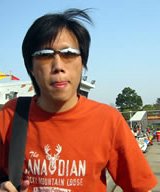Saturday, August 12, 2006
Wednesday, June 21, 2006
Round 1
- How is your day so far?
- What have you achieved in the past 5 years
- Tell me about the fleet.
- What did you go wrong in your previous applications?
- How have you nuture your interest in the past 5 years?
- How confident are you to perform in the role?
- Can you drive? What is the maximum speed you drive?
- If you are driving constantly at 100kmh, how far will you travel in 3 mins?
- What do you normally read?
- Any problem threading water for 15 minutes?
- Can you swim?
- What are you afraid of? Cockcroaches? Insects?
- Are you able to take it if you are put into a confined space?
- Are you afraid of dark?
- When will you be able to join us if you are selected?
- Do you have any question?
Tuesday, April 11, 2006
FAQs #1
1. What happens if a fully loaded aircraft needs to abort the takeoff after V1? After V2?
1. Pilots are trained not to abort a take off after the V1 (decision) speed as the safety of this action is not guaranteed. Manufacturers of plane assure the airlines that it is perfectly safe to abort a takeoff before V1 without any problems. To abort after V1 or V2 (theoritically, not possible to do so because V2 speed is achieved only after the airplane is already in the air) is a no-no! Why? The brakes pads are not designed to handle high-speed aborts and the plane is likely to run out of runway. Even if the remaining runway is long enough, the brake pads will get overheated and a fire is very likely. On the other hand, it is perfectly safe to continue with the take off after V1 after an engine failure as all pilots have been thoroughly trained to do so.
2. Why does a certain airline fly the Polar route with Boeing 777 while another doesn't? Is it true that Polar route is only flown in wintertime? If so, why?
2. Flying the Polar routes is mainly a question of economics and also a decision based on airline policy. It is not true that Polar routes are only flown during wintertime.
3. Why doesn't Boeing "standardize" the cockpit like Airbus does?
3. Yes, standardizing the cockpit as Airbus does in the later generation planes is a good concept that Boeing was slow to implement until the Boeing 787 came along. According to Boeing, a Boeing 777 pilot only need to do a refresher course of about 3 days to upgrade to the new Dreamliner (B787) as the cockpit instrumentation is quite similar.
4. When pilots chitchat in the cockpit, will their conversation be taped by the black box and circulated by engineers/personnel who handle the black box?
4. Any conversation in the cockpit is recorded in the CVR (cockpit voice recorder - a part of the black box) but they are automatically erased after every 30 minutes
5. Airline captains are under pressure to carry as little fuel as possible while within the safety limit. How is the "fuel quota" kept track?
5. Minimum fuel policy varies from airlines to airlines but all are within the limits as prescribed by ICAO. As the cost of fuel escalates, carrying more fuel than what is required for a safe flight becomes uneconomical. Hence, airlines monitor the fuel uplifted by checking the minimum fuel planned with the actual fuel carried on board through the voyage reports or via the data link after airborne. It is the responsibility of the captain to justify any extra fuels taken (due to weather, technical reason. etc).
6. The last time when I flew from Beijing, there were still ice/snow on the wing at take-off. I have thought that the wings always need to be de-iced completely before taking off?
6. A deicing truck would remove any ice or snow on the wings after the pilot or the engineer deemed that it should be carried out. On a Boeing 777, it is permissible to proceed without any deicing with a light coating of frost up to one eighth of an inch (3mm) in thickness on the lower wing surface or any thin hoarfrost on the upper surface of the fuselage.
ICAO - International Civil Aviation Organization
V1 - The V1 of an aircraft is the V speed which refers to the critical engine failure recognition speed.
